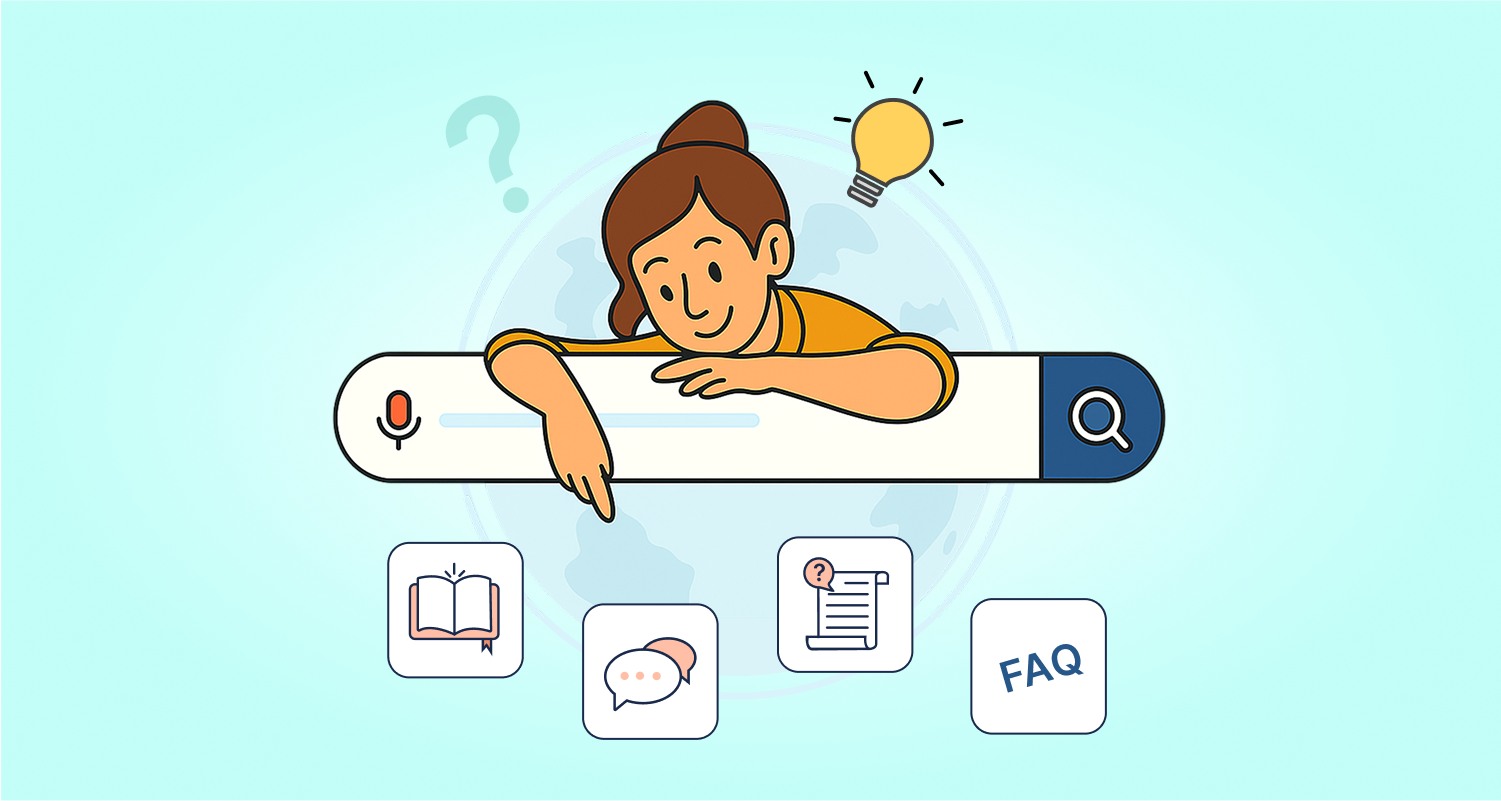Customers don’t want to wait, they want answers now. Whether they’re checking the status of a request or resolving a simple issue, most prefer finding solutions on their own.
That means no hold-music and no back-and-forth emails, just quick, convenient access to help whenever they need it.
As digital transformation continues to reshape customer expectations, more companies are turning to web self-service platforms to deliver faster support, reduce support-related costs, and boost satisfaction.
In this blog, we’ll explain what web self-service is, explore its key types, and share best practices for successful implementation.
What is web self-service?
Web self-service is an online solution that allows users to find information and resolve issues on their own, without needing help from a support agent.
It typically operates through a dedicated portal or a help center on your website, where users can log in or browse freely.
With 81% of customers attempting to resolve issues independently before reaching out, offering effective self-service options is essential.
These systems provide 24/7 access through user-friendly interfaces, enabling customers to manage accounts, perform transactions, or find answers to common questions.
When embedded into websites or mobile apps, it delivers instant support and improves the overall customer experience.
Benefits of implementing web-based self-service platforms
Adopting a web self-service platform is more than just a support option; it’s a strategic move that aligns with modern customer expectations.
Customers expect fast, convenient, and always-available support. Below are some key benefits of implementing a web self-service solution in a customer-centric support strategy.
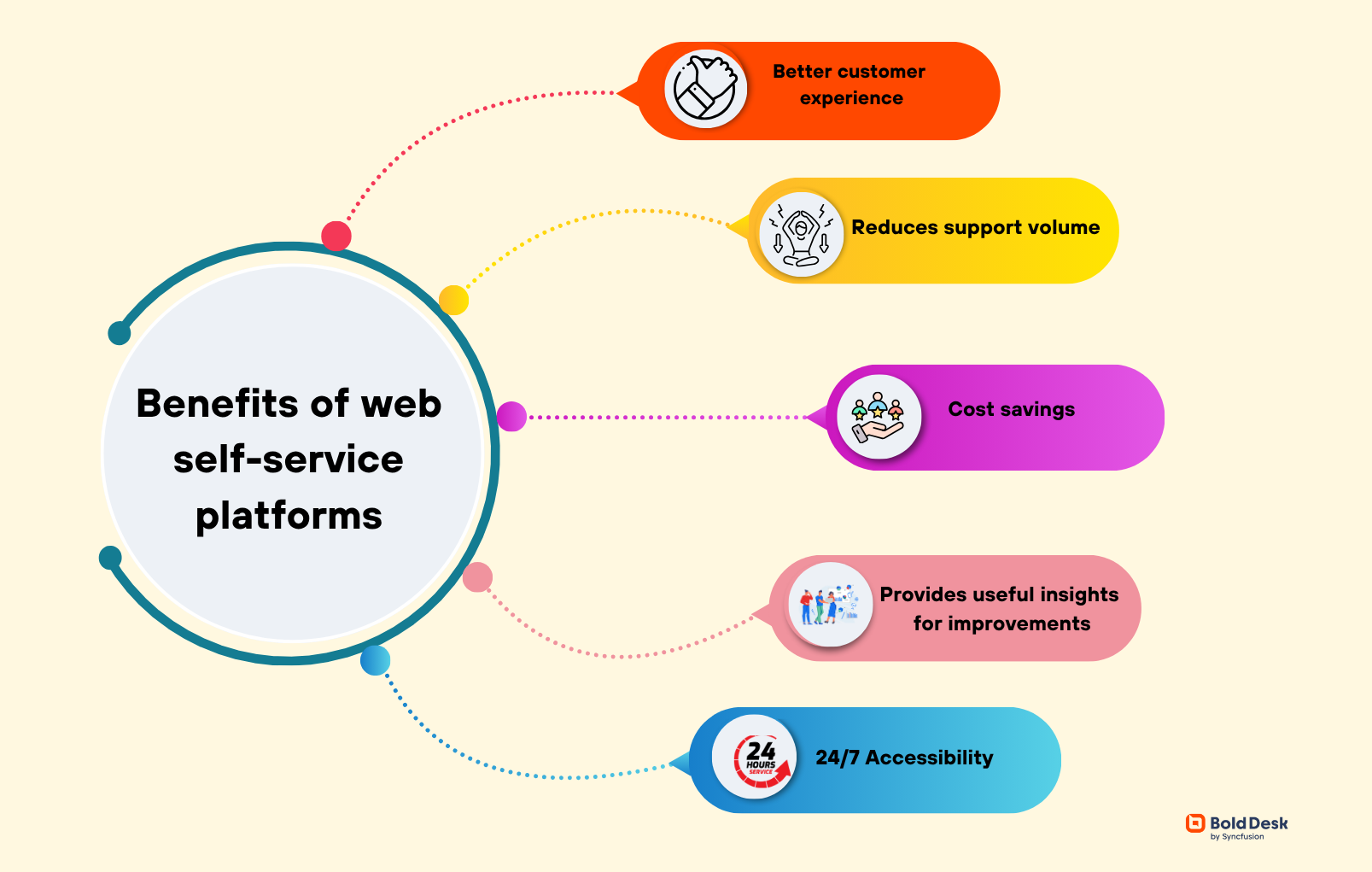
- Better customer experience: Web self-service provides customers with immediate access to the information they need. This eliminates the frustration of waiting in line or navigating complex interactive voice response systems.
- Reduces support volume: By enabling customers to find answers independently, businesses can significantly reduce the number of incoming support requests.
- Cost savings: Fewer tickets and calls mean fewer agents are needed, lowering operational costs.
- Provides useful insights for improvements: Businesses can see which resources are popular and which are ignored by analyzing search terms and usage trends. This helps them update support content and improve their products.
- Offers 24/7 accessibility: Unlike traditional customer support, web self-service platforms are available around the clock. This 24/7 customer service method ensures that users can access help whenever they need it, regardless of time zones or business hours.
Common types of web self-service tools
Web self-service isn’t one-size-fits-all. Different types serve different customer needs. Here’s a detailed look at the most common types:
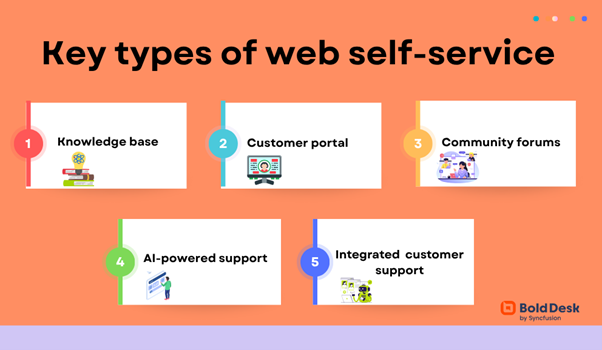
Knowledge base
A knowledge base software is a centralized repository of information that enables users to quickly find answers and resolve issues independently without needing to contact support.
It includes resources like FAQs, product manuals, tutorials, troubleshooting guides, how-to videos, and how-to articles.
There are two categories of knowledge base:
- External knowledge base: Is a self-service resource that is publicly accessible for all users.
- Internal knowledge base: Used within an organization to provide information to employees, such as company policies, training materials, or troubleshooting guides.
How to improve your knowledge base
To build an effective personal knowledge base, consider the following:
- Start by identifying key topics to guide your content.
- Use a consistent format that outlines the problem, solution, and steps.
- Boost clarity and engagement with visuals like GIFs, screenshots, diagrams, or videos to enrich explanations.
There are various tools available to support this process. For example, BoldDesk includes a comprehensive multilingual knowledge base software that helps teams create, manage and share useful web self-help resources to their users.
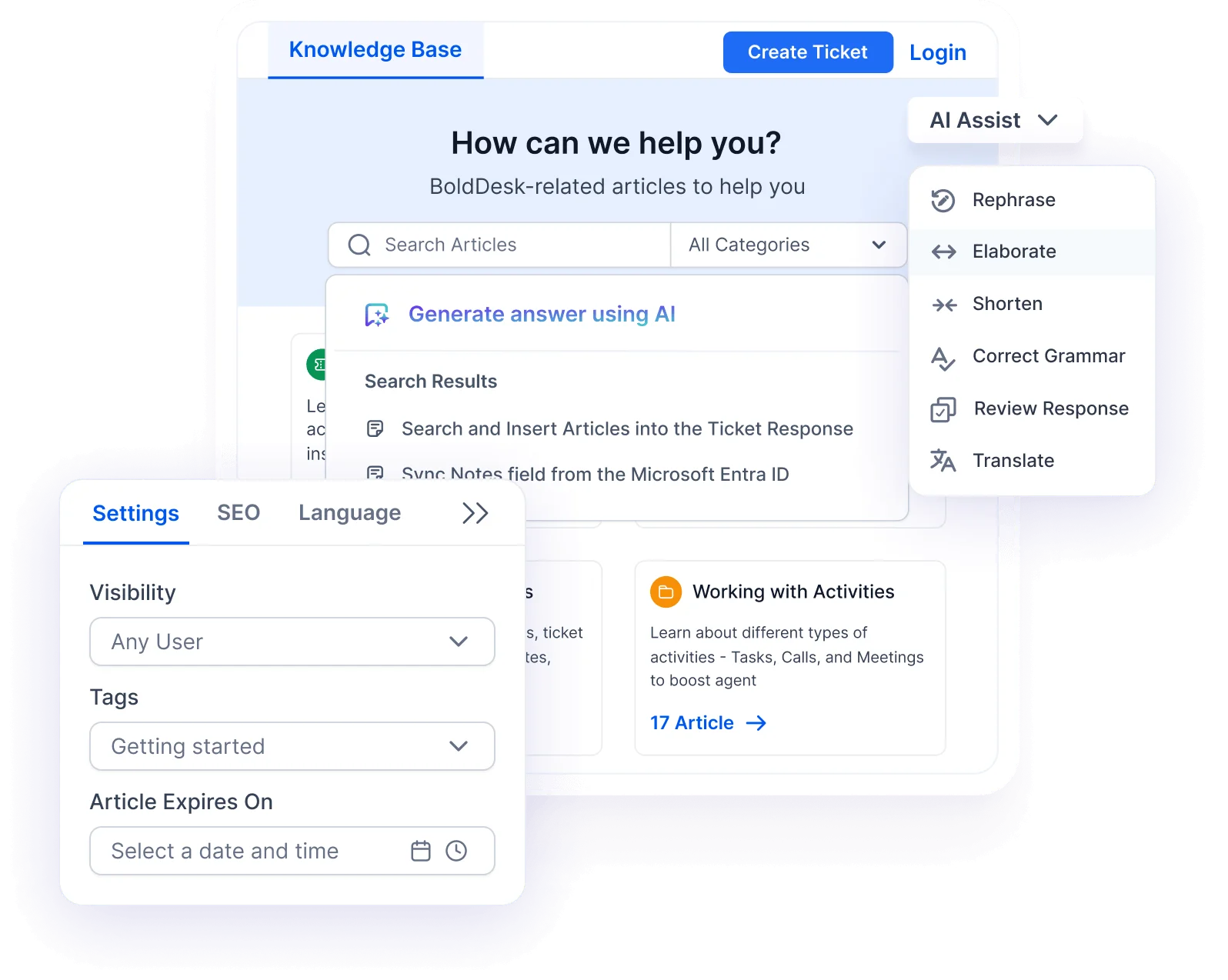
Customer portal
A customer portal software is a secure, login-based platform where customers can access personalized content and self-service tools to manage their support needs independently.
Unlike a publicly accessible knowledge base, a customer portal is private and personalized. It offers secure access to account-specific support and exclusive resources tailored to each user’s needs.
Through the portal, customers can:
- View and manage their support tickets.
- Access exclusive resources and documents.
- Submit feedback and track request statuses.
How to improve the customer portal:
- Choose a customizable platform: Select a branded portal that integrates smoothly with your CRM and support tools.
- Ensure consistent user experience: Match the portal’s design and navigation with your main website for familiarity and ease of use.
- Use portal software for seamless transitions: Simplify branding and create a unified experience between your website and support environment.
For example, platforms like BoldDesk allow businesses to build fully branded, integrated client portal software that enhance customer satisfaction while reducing support workload.
Community forums
A community forum is a dedicated space on your website where customers can connect, ask questions, share insights, and support one another.
These forums foster collaboration, boost engagement, and reduce support requests by enabling users to crowdsource solutions.
While many discussions focus on your product, users often explore broader topics of shared interest.
In fact, according to Higher Logic, 62% of customers are more likely to buy from brands with active, visible communities.
How to build a thriving community forum:
- Set clear participation guidelines
- Encourage early engagement through rewards
- Assign moderators to maintain a respectful and helpful environment
A well-managed forum not only deflects support tickets but also builds a sense of belonging, making customers feel engaged and supported.
Chatbot and AI-powered support
AI-powered self-service tools are transforming web support by enabling faster, smarter, and scalable customer assistance. These tools use artificial intelligence, natural language processing (NLP), and machine learning to understand user intent, automate responses, and improve over time.
There are three main types:
- AI Copilots, which guide users to relevant help content using contextual understanding.
- AI agents, which autonomously handle tasks like order tracking or account updates by integrating with backend systems.
- Traditional chatbots, which follow predefined rules to answer common queries in real time
By combining these AI web self-service tools, businesses can learn from interactions, detect customer emotions, and continuously improve accuracy and efficiency, resulting in faster, more personalized support.
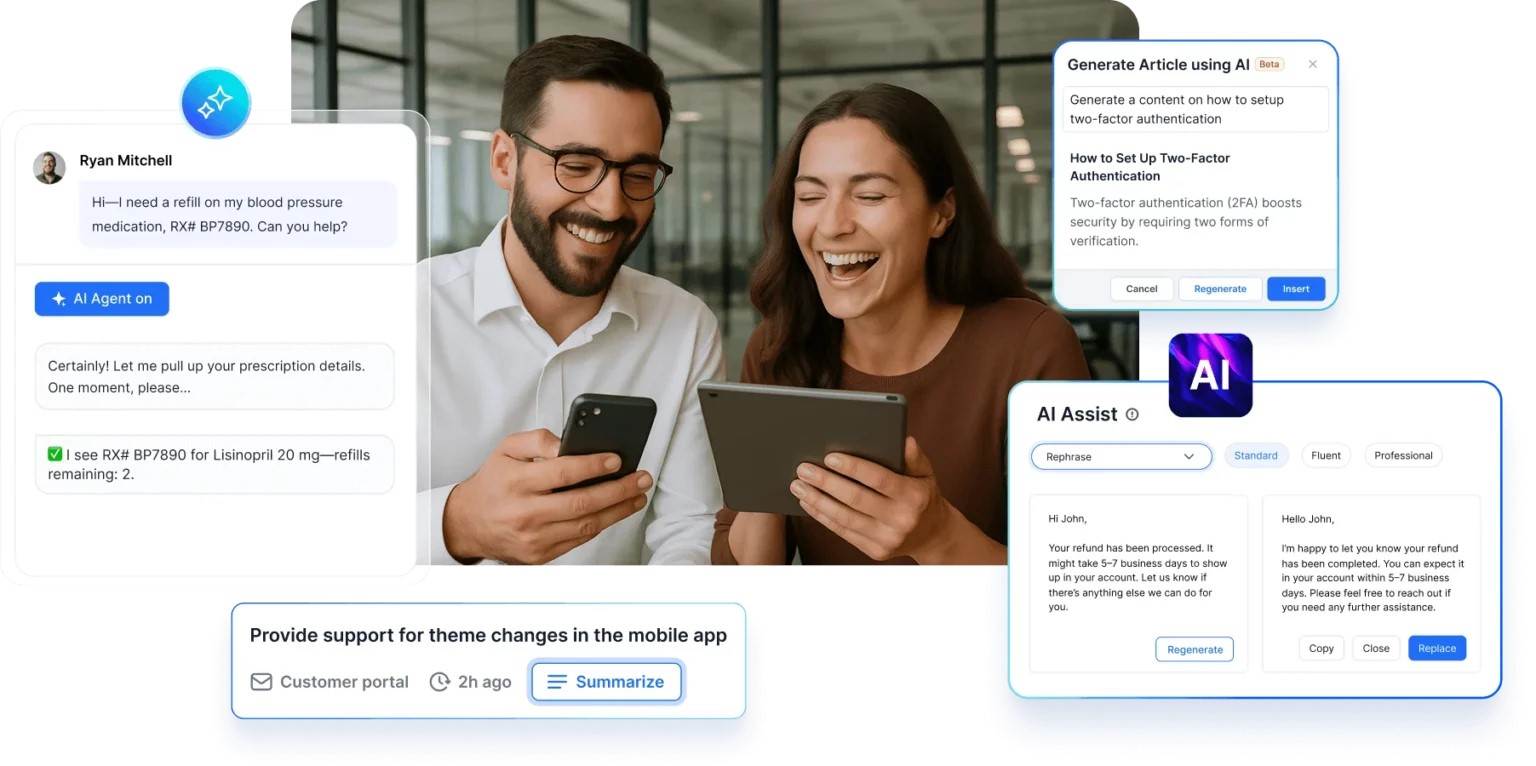
Integrated customer support
Integrated customer service refers to a unified system that brings together all your support channels, tools, and customer data into a single centralized platform for users.
This unified approach enables customers to smoothly access and navigate various self-help articles, based on their needs.
If users can’t find a solution through self-service, they can request help by submitting a ticket or contacting support directly from the page. This makes self-service faster, easier, and more effective.
Best practices for implementing web self-service
Your web self-service approach will naturally vary depending on your industry, company size, customer base, and available resources.
However, the fundamental steps for building an effective self-service experience remain consistent across all types of businesses and platforms. These include:
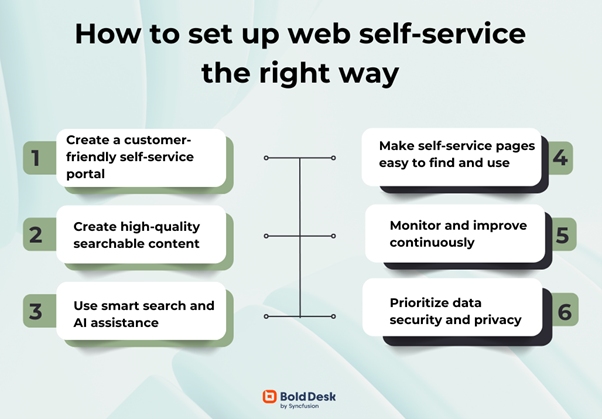
Build a self-service website that works for your customers
Your first move in creating a web-based self-service experience is choosing the right platform.
Whether you’re leveraging built-in CRM tools or investing in specialized customer self-service portal like BoldDesk, the goal is the same: make support simple and accessible.
How to implement:
- Choose your platform wisely – Consider your existing tools, budget, and scalability needs.
- Pick the right formats – FAQs, knowledge bases, community forums, and customer portals each serve different needs. Use customer data to guide your choices.
- Track and adapt – Monitor common questions and user behavior to refine your self-service offerings over time.
By selecting the right tools and tailoring your self-service formats to what your customers need, you build a support system that’s not only efficient but also scalable and user-friendly.
Create high-quality content
If your self-service content isn’t clear, helpful, or easy to find, users won’t stick around, they’ll head straight to support. The heart of a successful web self-service strategy is high-quality, user-friendly content that speaks to the needs of different types of customers.
When your resources are well-written, searchable, and visually engaging, users are more likely to find answers on their own.
How to implement:
- Write for clarity and discoverability – Create easy-to-follow guides using relevant keywords to improve search visibility. Structure content with headings, bullet points, and visuals to make it scannable and engaging.
- Keep content inclusive and up to date – Regularly expand your knowledge base to reflect evolving customer needs. If you serve a global audience, offer multilingual support to ensure accessibility for all users.
Investing in quality content means fewer support tickets and happier customers who feel confident solving issues on their own.
Use smart search and AI assistance
Customers often don’t know the exact terms to search, which can make finding the right help frustrating.
Smart search, powered by AI, enhances accuracy and speed by understanding natural language and user intent, guiding users to the most relevant content faster.
For example, BoldDesk’s knowledge-based AI search feature uses intelligent algorithms to interpret queries, suggest relevant articles, and deliver instant answers, improving the overall self-service experience.
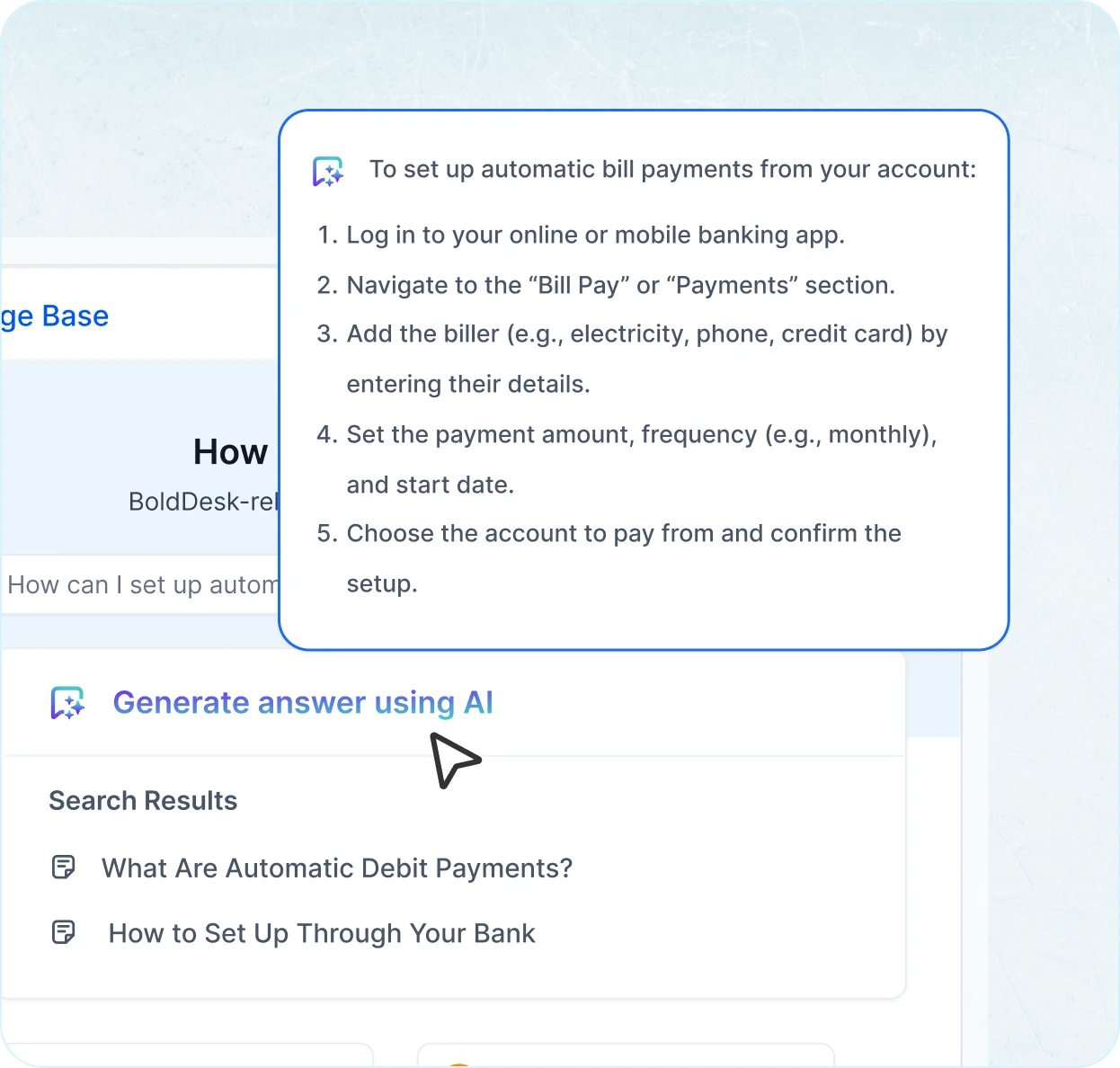
How to implement:
- Smart search – Implement AI-powered search with natural language understanding.
- AI assist – Offers autocomplete, filters, and related article suggestions.
By making the content easier to find relevant information, smart search reduces friction and increases self-service success rates.
Make self-service pages easy to find and use
Ever landed on a website and struggled to find help? Your customers feel the same when self-service pages are buried or hard to navigate. A seamless support experience starts with easy access to help resources and intuitive page design.
When users can quickly locate what they need, whether it’s a knowledge base, FAQ, or contact option, they’re more likely to solve issues independently and leave satisfied.
How to implement:
- Enhance visibility and clarity – Add links to self-service resources in the main menu, navigation bars, and footer. Use clear labels like “Help Center” or “Support” to guide users.
- Optimize usability across devices – Ensure the layout is intuitive and mobile-friendly. Include “Contact Support” or “Still need help?” options on every page to offer additional assistance.
Monitor and improve continuously
Launching your web self-service platform is just the beginning, its long-term success depends on continuous monitoring and refinement.
As customer needs, behaviors, and your products evolve, it’s essential to regularly review analytics, gather feedback, and analyze usage patterns to keep your platform relevant and effective.
How to implement:
- Monitor relevant metrics – Track key performance indicators like search success rate, bounce rate, and ticket deflection.
- Analyze and improve – Regularly perform customer service audits and update content based on analytics and product changes.
By making data-driven improvements, you ensure your self-service experience remains high performing, customer-centric, and aligned with evolving expectations.
Prioritize data security and privacy
Users must trust that their personal information is protected. Security breaches can lead to serious legal, financial, and reputational consequences.
How to implement:
- Use secure authentication methods and HTTPS encryption.
- Protect sensitive data and comply with regulations like GDPR or HIPAA.
By prioritizing data security and privacy, you build customer trust, ensure compliance, and safeguard your business from potential risks.
Common examples for web self-service tools
Web self-service empowers users to independently resolve issues, access information, and complete tasks through digital tools, enhancing convenience and reducing support demand.
Below are some common examples of how businesses apply web self-service across industries.
BoldDesk: Integrated customer support
BoldDesk is an AI-powered integrated customer support system that provides a comprehensive suite of web self-service tools for its internal and external users with direct access to all support resources.
From this centralized hub, users can access the knowledge base, submit and track support tickets, get real-time live chat support, and receive AI-powered article suggestions based on their queries.
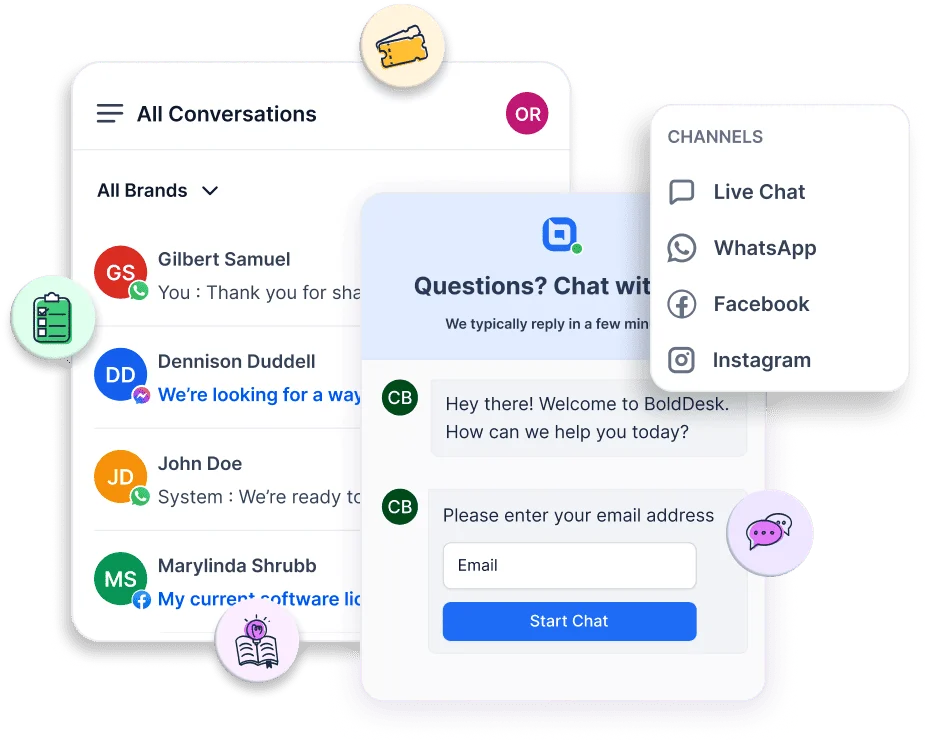
If the available resources aren’t sufficient, clear instructions are provided on how to submit a ticket or contact a support representative directly.
Coursera: Learner help center
Coursera’s Help Center provides learners with access to a wide range of self-service tools, including FAQs, course guides, and account management resources.

Users can troubleshoot payment or access issues and receive personalized article suggestions based on their questions. If further help is needed, they can escalate to support through the contact options provided.
Microsoft: Support site
Microsoft’s support site features a comprehensive self-service experience with product-specific help articles, guided troubleshooting tools, community forums, and downloadable updates.

Users can resolve most issues independently through intuitive navigation and search. For more complex problems, the site offers escalation paths to live support.
Boost support and customer satisfaction with web self-service
Web self-service creates a win-win customer service experience, offering convenience and efficiency for both businesses and customers.
Through AI-powered web self-service tools, users can independently find answers and solve problems without direct support intervention.
BoldDesk transforms this into a smarter, scalable solution. Customers access a branded help center to search articles, manage tickets, and receive AI-powered suggestions, reducing ticket volume while enhancing satisfaction.
The more self-service options you provide, the more proactive and consistent your support becomes. Contact us today to start developing your web self-service strategy with BoldDesk for more efficient support.
Did you find this article interesting? Provide your suggestions and ideas in the comment section below.
Related articles

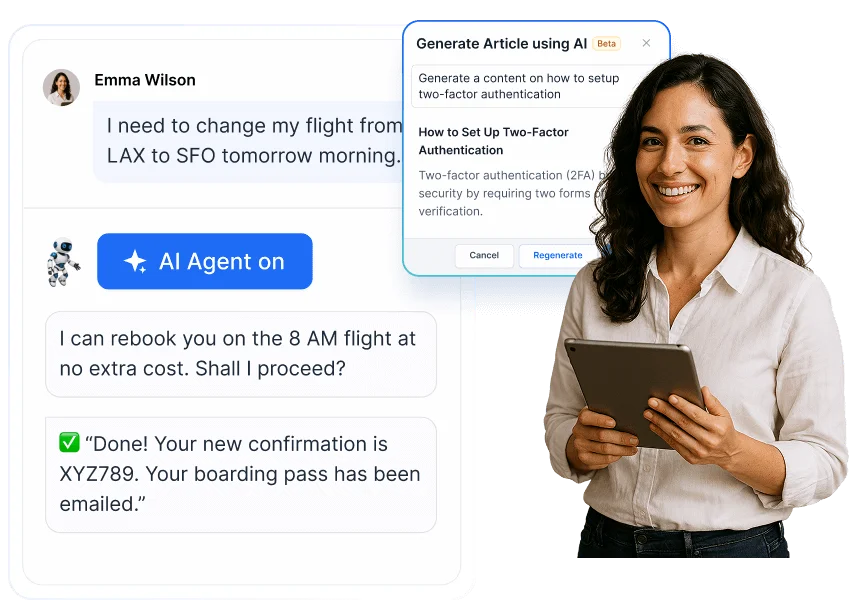

















 Email Ticketing System
Email Ticketing System Shared Inbox Software
Shared Inbox Software Multi Brand Help Desk
Multi Brand Help Desk Internal Help Desk Software
Internal Help Desk Software Trouble Ticketing Software
Trouble Ticketing Software Mobile Help Desk
Mobile Help Desk 










